

Target crop
Uniform growth and equal development of the stems should continue and the leaf area should increase to enable the plant to intercept as much radiation as possible.
Target root zone
The pin roots should grow easily out of the block and uniformly into the growing media. It is important to supply enough water and nutrition to the blocks until the plant can rely on the available water in the slab.
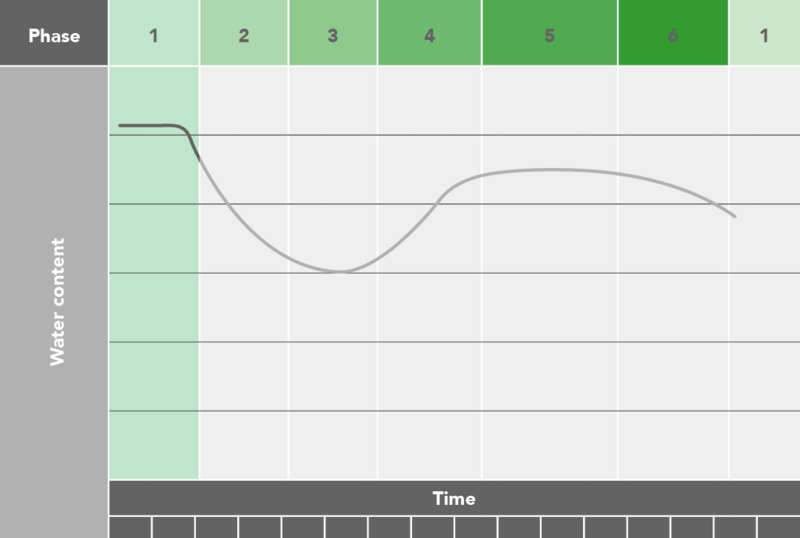
Start of phase
Plants arrive into the greenhouse.
End of phase
When the roots have penetrated into the substrate several centimeters and water absorption is no longer dependent on the moisture content in the block.
Objective phase
Fast and uniform rooting in, so that the roots are penetrating the growing media in line with the plant size.
Option 1:
Pre-draining the slab by puncturing the plastic wrapper with a small hole just above the seam will create a small reservoir of water at a uniform height in each slab throughout the greenhouse. This layer of water ensures that the propagation block will remain sufficiently and uniformly wet so in the first 48 hrs after planting only 1 or at most 2 irrigation sessions will be required to stimulate root penetration into the slab (applies to Plantop blocks only).

This way of cutting the drain holes is the preferred choice for 10 cm high slabs. Stop irrigating from the moment the plant is rooted 2 - 3 cm into the underlying slab and until the final drain hole is cut, which will be after 4 - 7 days. Ideally the final drain hole can be made by cutting along the width of the plastic seam with scissors or by cutting one hole on the side of the slab at its lowest point. It will find it easier to cut the drain hole while there is still excess water in the bottom of the slab effectively pushing on the side-walls of the plastic foil.
Option 2:
If you wish to cut the drain holes directly, first drain the excess water from the slab by making a small puncture just below the plastic seam. Return to the slab once it is drained and cut one drain hole per slab, at the end of the slab or ideally by cutting along the seam across the width of the slab.

In the first 3 to 4 days after planting aim at irrigating every 8-10 hours 150ml/m². With 1.5 plants per m² this should be about 100ml per plant/dripper. Every day as the roots start to enter the slab you should aim for one less dripping cycle. This will stimulate the pin roots to enter the slabs quickly and promote the continued generative development of uniform stems.
It is important to set targets / goals for the root zone. Where do you want to be and by when in terms of substrate WC% & EC? In this respect the GroSens system is the ideal tool on which to base your management decisions – i.e. optimize your start time to avoid issues with cold stripe or Mycosphearella later in the cultivation. While the screens are in place compensate for the lower water uptake by the plant by making sure the EC of the irrigation water used to saturate the slab initially and in the applied irrigation is high enough (both are generative actions). The crop will grow quickly, ‘eating’ the nutrients in the slab so be mindful of the substrate EC and increase the drip EC as required.
Good water management is critical for a successful crop. It starts in this growth phase. While the screens are in place compensate for the lower water uptake by the plant by making sure the EC of the irrigation water used to saturate the slab initially and in the subsequent drip is high enough (a generative action). The crop will grow quickly be mindful of the substrate EC and increase the drip EC as required. For accurate EC control during the entire (2 or 3 crop) cultivation cycle we recommend you cut one drain hole at the lowest point in each slab. make sure this is done properly, poorly cut drain holes will have a huge impact on your ability to steer the substrate WC & EC. More than one drain hole will result in an uneven WC & EC within the slab and will also make steering (WC & EC) on irrigation session length (ml/m²) harder.

Remember the drain water from Grodan slabs can be recycled from the very start of the cultivation cycle. In the first 3 to 4 days after planting aim at irrigating every 8-10 hours 150ml/m². With 1.5 plants per m² this should be about 100ml per plant/dripper. Every day as the roots start to enter the slab you should aim for one less dripping cycle. This will stimulate the pin roots to enter the slabs quickly and promote the continued generative development of uniform stems.
It is important to set targets / goals for the root zone. Where do you want to be and by when in terms of substrate WC% & EC? In this respect the GroSens system is the ideal tool on which to base your management decisions – i.e. optimize your start time to avoid issues with cold stripe or Mycosphearella later in the cultivation.
| Bright day - Vegetative steering | Dark day - Generative steering | ||||||
| Start time | First days during rooting in irrigate every 4.0 - 5.0 hrs (subject to way drain hole is configured) | First days during rooting in irrigate every 4.0 - 5.0 hrs (subject to way drain hole is configured) | |||||
| Stop time | Not applicable | Not applicable | |||||
| Target day level WC | Slab >70%, Block >50% | Slab >70%, Block >45% | |||||
| Target decrease WC overnight | Not applicable | Not applicable | |||||
| Moment 1st drain | Not applicable | Not applicable | |||||
| EC drip | 2.5 - 3.5 mS/cm | 3.0 - 3.5 mS/cm | |||||
| EC slab | 3.0 - 4.5 mS/cm >4.0 mS/cm using fixed energy screen (plastic foil) | 3.0 - 4.5 mS/cm >4.0 mS/cm using fixed energy screen (plastic foil) | |||||
| 24 hr drain | Not applicable | Not applicable | |||||
| Irrigation volume | 80 - 100 ml/block | 80 - 100 ml/block | |||||
| ml/joule | Not applicable | Not applicable | |||||
| Night irrigation | If decrease >20% | If decrease >20% | |||||
Before planting, it is essential to fully saturate all the slabs with nutrient solution for at least 24 hours before the drain hole is cut. This ensures that even the fine pore spaces between the NG2.0 fibres are filled with water.
There are two ways to cut the drain hole. Watch the video below on how to do this correctly. For GT Master 10 cm slabs the preferred method is by first predraining the slab. GT Master 10 cm is designed to promote generative plant development providing maximum synergy between root zone and climate strategies. In order to facilitate maximum generative - vegetative steering of WC% and EC in the root zone throughout the duration of the cultivation you are advised to cut one drain hole per slab. Remember with GT Master 10 cm it is perfectly safe to recycle the drain water from the moment the drain holes are cut. This will help reduce unwanted emission of fertilizer to the environment.
Target crop
Work on plant development and increasing the leaf area to capture the available radiation and keep the required vegetative – generative balance in the plant relative to the fruit load and light levels.
Target root zone
Establish complete root penetration in the entire volume of the growing media. This will enable the plant to take up all the water and nutrition it will need for maximum summer production and quality.
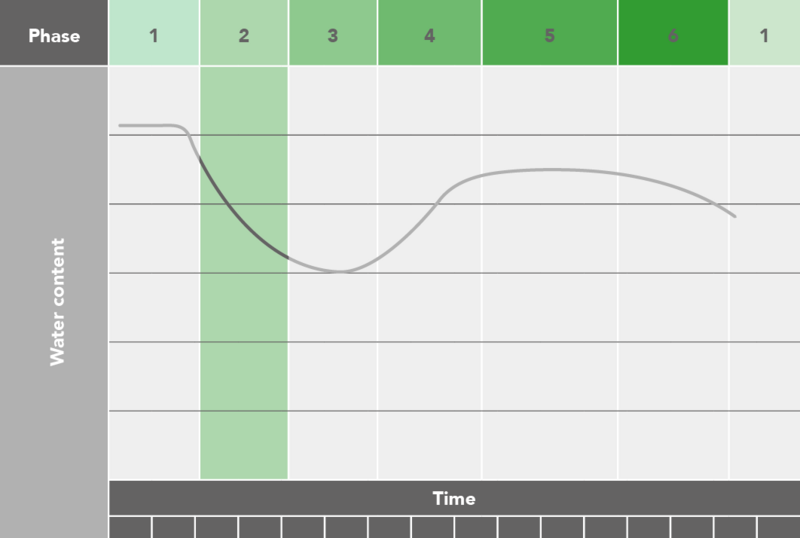
Start of phase
When the roots have penetrated into the substrate several centimeters and water absorption is no longer dependent on the moisture content in the block.
End of phase
When the plant starts to feel the effects of the fruit load.
Objective phase
Set the first fruits at the desired internode and continue their development and the realisation of a root system that fills the entire volume of the growing media.
The crop is now rooted into the slab so ensure your GroSens sensor is positioned in the slab correctly.
On cloudy days the need for water will be dependent on the developing fruit load and the condition of the crop in combination with other climatic factors such as pipe temperature and venting. Therefore the starting time of irrigation must be continuously adjusted to the crop’s condition and the climatatic conditions. In the morning the WC% graph should first show a sharp decrease in WC% before irrigation can be started. This will avoid unwanted root pressure when the fruit load is temporarily low and avoid fruits being rejected due to Mycosphearella.

On sunny days the young fruits will swell during the early evening hours. Therefore depending on the climatic conditions and ventilation strategy water uptake may continue until late in the evening. This will be clearly visible on the GroSens graphic. If the WC% decreases too fast (>4% within 3 hours of stopping) it may be necessary to give an extra irrigation around 23:00 hrs.
The young cucumber crop will require a lot of nutrition until the first fruits begin to swell. On days with little radiation (or if the slab EC is lower than drip EC) the drip EC should remain high typically in the region 3.0 – 3.5 mS/cm.
A controlled EC in phase 2 will lead to uniform stem development and good fruit quality. Low nutrient levels in the root zone will lead to weak chlorotic heads, especially with as the fruit load develops on the main stem. In later phases this will lead to lower production and fruit quality.
To get an appreciation of the uniformity of WC% and EC between the slabs the GroSens handheld system or the Reader with a GroSens sensor in ‘kit mode’ is a perfect tool.

On cloudy days the need for water will be dependent on the developing fruit load and the condition of the crop in combination with other climatic factors such as pipe temperature and venting. Therefore the starting time of irrigation must be continuously adjusted to the crop’s condition and the outside climate. In the morning the WC graph should first show a sharp decrease before irrigation can be started.
This later issue will avoid unwanted root pressure when the fruit load is temporarily low and avoid fruits being rejected due to Mycosphearella.
On sunny days the young fruits will swell during the early evening hours. Depending on outside conditions and ventilation strategy crop water uptake may continue until late in the evening. This will be clearly visible on the GroSens graphic. If the WC decreases too fast (>4% within 3 hours of stopping) it may be necessary to give an extra cycle around 23:00 hrs. The young cucumber crop will require a lot of nutrition until the first fruits begin to swell. On days with little radiation (or if slab EC is lower than drip EC) the drip EC should remain high (3.0 – 3.5 mS/cm).
A controlled EC in this phase will lead to uniform stem development and good fruit quality. Low nutrient levels in the root zone will lead to weak chlorotic heads, especially with as the fruit load develops on the main stem. In later phases this will lead to lower production and fruit quality.
Information on how to position the GroSens in the slab can be found here.

| Bright day - Vegetative steering | Dark day - Generative steering | ||||||
| Start time | +2.0 hrs after sunrise. At least 1.0 hr after opening energy screen | +3.0 hrs after sunrise At least 1.0 hr after opening energy screen | |||||
| Stop time | -2.0 hrs before sunset. At least 2.0 hrs before closing energy screen | -3.0 - 4.0 hrs before sunset. At least 2.0 hrs before closing energy screen | |||||
| Target day level WC | Gradually decreasing to 60% | Gradually decreasing to 55% Top layer >40% | |||||
| Target decrease WC overnight | 7 - 8% | 9 - 10% | |||||
| Moment 1st drain | +4.0 hrs sunrise | +5.0 hrs sunrise | |||||
| EC drip | 2.8 - 3.5 mS/cm +0.5 mS/cm using fixed energy screen | 3.0 - 3.5mS/cm +0.5mS using fixed energy screen | |||||
| EC slab | 3.0 - 3.5 mS/cm +0.5 mS/cm using fixed energy screen | 3.3 - 3.8 mS/cm +0.5 mS/cm using fixed energy screen | |||||
| 24 hr drain | 15 - 25% | 0 - 15% | |||||
| Irrigation volume | 200 - 300 ml/m² | 250 - 300 ml/m² | |||||
| ml/joule | Not applicable | Not applicable | |||||
| Night irrigation | Stimulating development young fruit or shoots if decrease WC >8% | High pipe temp (>60°C) or decrease WC >10% | |||||
The concept of Precision Growing combines variety, climate and irrigation strategies in an optimal way. In Phase 2 work on gradually reducing the day level WC% and increasing the growing media EC until first setting. This strategy will further enhance root penetration throughout the entire volume of the growing media. NG2.0 technology has allowed Grodan to increase the height of the growing media without loss of the slabs functional performance (uniformity of WC% and EC). The added benefit of GT Master 10 cm is an additional 25% rooting volume in the centre of the growing media (assuming like for like volumes versus 7.5 cm high slabs per m²). These roots will be more efficient than those in the bottom layer of the slab. Importantly towards the end of this phase you will require minimal irrigation volumes to stabilize and refresh the EC. Consequently “flushing” the growing media is not required, thereby you are able to facilitate maximum generative steering.
Target crop
Growth should remain constant and uniform. The 24 hrs temperature should be adjusted to the light levels to ensure optimum partitioning of available assimilates for plant and fruit growth.
Target root zone
Root quality and activity should be retained to ensure controlled and uniform re-growth of the crop from the harvest of the fiuits on the main stem. The decrease of WC% during the night will provide a good indication for the level of plant activity during the day.
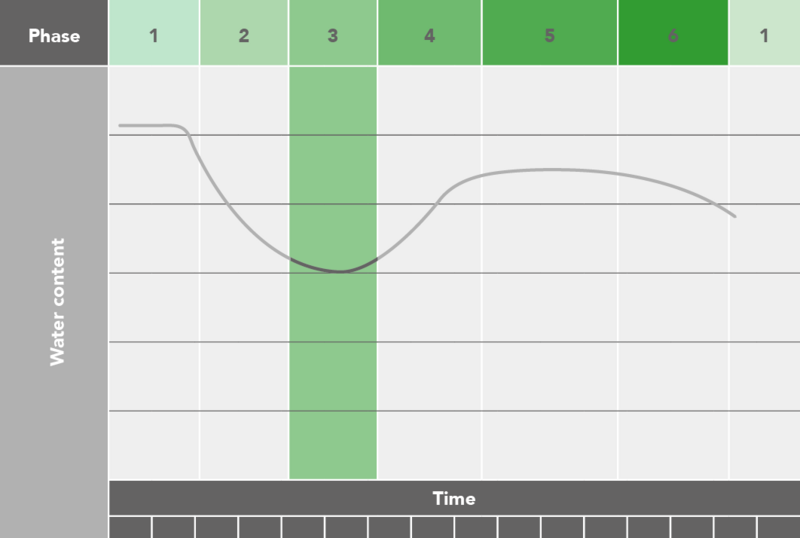
Start of phase
When the plant starts to feel the effects of the fruit load.
End of phase
Following the first harvest, when the pressure of the fruit load is starting to decrease.
Objective phase
Avoid shocks in development by retaining the right balance in fruit load and growing power in the plant for the growth of strong lateral shoots. The combination of harvest of the first fruits and new fruit setting (as the fruit load continues to increase) must be in line with assimilates supply which is variable and strongly depending on the weather.
There are 4 key irrigation stages during the day:
Optimise start and stop times.
Keep radiation sum used to trigger an irrigation constant throughout the entire day. Instead vary the irrigation volume to adjust drain levels.
At this time of year the radiation sum start per irrigation will be set around 100 J/cm², remembering ventilation is not on summer levels. As the transpiration levels increase the irrigation frequency can be lowered to every 70 - 80 J/cm².
Do not allow the WC% in the slab to fall too far >15% this will be at the expense of growth, vigor and fruit weight.
| Bright day - Vegetative steering | Dark day - Generative steering | ||||||
| Start time | +1.0 - 2.0 hrs after sunrise 80 - 100 J/cm² or 200 W/m² | +3.0 - 4.0 hrs after sunrise. When WC falls 1.5 - 2.0% from sunrise | |||||
| Stop time | -1.0 - 2.0 hrs before sunset. Ideally leaving 100 -150 J/cm² and a light intensity threshold 200 - 250 W/m² to sunset | -3.0 - 4.0 hrs before sunset | |||||
| Target day level WC | 60 - 70% | 55 - 65% | |||||
| Target decrease WC overnight | 7 - 8% | 8 - 9% | |||||
| Moment 1st drain | +4.0 hrs sunrise or radiation 400J/cm² or 600 W/m² | +5.0 hrs sunrise or within 4 irrigations | |||||
| EC drip | 2.3 - 3.0 mS/cm | 2.7 - 3.3 mS/cm | |||||
| EC slab | 2.8 - 3.5 mS/cm | 3.0 - 3.8 mS/cm | |||||
| 24 hr drain | 20 - 30% | 10 - 20% | |||||
| Irrigation volume | 200 - 250 ml/m² | 250 - 300 ml/m² (pay attention to the temperature of the irrigation water!) | |||||
| ml/joule | 3.0 ml/J | Not applicable | |||||
| Night irrigation | Stimulating development young fruit or shoots if decrease WC >8% | No | |||||
The growth of new roots and root tips should be encouraged by adjusting the start and stop times of irrigation especially on darker days. The confidence to steer the slab on low day level WC%, especially on the dark days is made possible due to the improved uniformity WC% over the height of GT Master 10 cm. The drip and slab EC’s are also important steering tools to maintain balance and fruit quality in this phase. As the GT Master 10 cm has good irrigation efficiency, it allows the drip EC to be maintained sufficiently high while the slab EC remains stable. In combination with late start and early stop times especially on dark days. This provides maximum generative development. Importantly it means that you do not have to “chase” EC of the growing media by applying additional water and creating unnecessary and unwanted drainage. On bright days the re-saturation characteristics of GT Master 10 cm allow the WC% to be steered upwards. In combination with a targeted irrigation strategy this will facilitate maximum growth and development of the crop.
Target crop
Prepare the crop for summer creating the right balance as the plant load and production continue to increase.
Target root zone
To support increasing transpiration levels the root zone environment needs to be prepared. The recommended WC% and EC levels for maximum production.
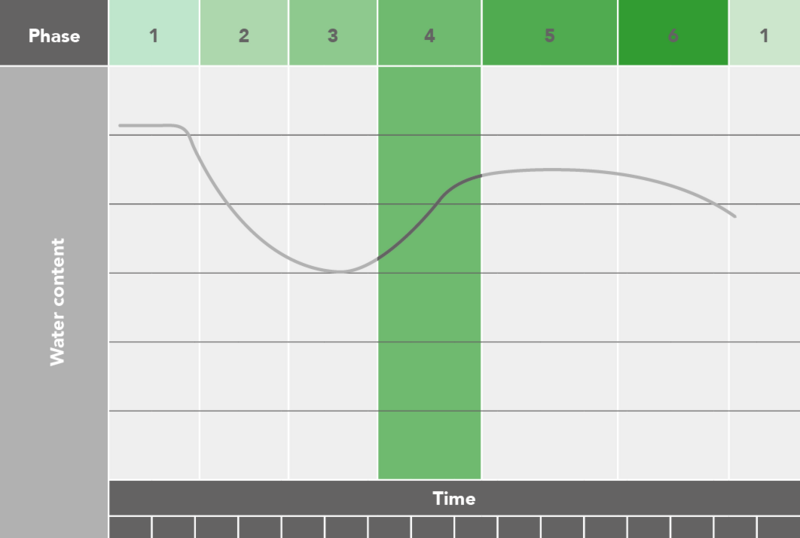
Start of phase
Following the first harvest, when the pressure of the fruit load is starting to decrease.
End of phase
When production levels are stable.
Objective phase
Realise controlled and uniform re-growth of the crop for smooth transistion to harvesting fruit on the lateral stems.
In this phase pay attention to the irrigation and slab EC. The GroSens sensor can give you lots of useful information to help you decide if the start and stop time of irrgation are correct for different weather conditions.
Prevent the ingress of Mycosphaerella in this phase by optimizing the start time of the irrigation in combination with sufficient minimum pipe in the morning. This will minimize the potential of infection by avoiding condensation (stems) and root pressure (leaves). Using larger irrigation volumes i.e. 4 - 5% of substrate volume /m² for the first 3 or 4 irrigation cycles of the day will make it possible to start irrigating when the plant is active and still realise EC refreshment (drain) on time. Remember in dark weather it is most likely that the maximum rest time setting in the climate computer will be driving the irrigation strategy, so ensure this is not too set too high. Remember in periods of changeable weather the EC of the growing media should not decrease on a dark day compared to a bight day. If it does increase the maximum rest time setting in the afternoon of the dark day and realize less drain. If the crop requires steering more generatively a greater decrease in WC (8 - 9%) will help stimulate flowering.
An EC which is high enough will give stronger flowers and better quality shoots so it is better to control slab EC by achiveving sufficient but not excessive drain on a bright day rather than lowering the irrigation EC. Aim to keep the average slab EC relatively stable (within 0.5 mS/cm) to allow consistent plant development and fruit quality.
On sunny days the young fruits will swell during the early evening hours. Depending on outside conditions and the ventilation strategy water uptake by the crop may continue until late into the evening. This will be clearly visible on the GroSens graphic. If the WC% decreases too fast i.e. >4% within 3 hours prior to sunset it may be necessary to give an extra irrigation around 23:00hrs.
An incorrect stop time can lead to ‘Black fruits’. These are the symptoms of a crop that is drawing water from the fruits. This usually happens when the vigour of the plant is increasing with the “older fruit being more sensitive. To avoid black fruits prevent the susbtrate EC from rising and consider closing the climate screen 700 W/m².
| Bright day - Vegetative steering | Dark day - Generative steering | ||||||
| Start time | +1.0 - 2.0 hrs after sunrise 60 - 100 J/cm² or 150 W/m² | +2.0 - 3.0 hrs after sunrise When WC falls 1.5 - 2.0% from sunrise | |||||
| Stop time | -1.0 - 2.0 hrs before sunset. Ideally leaving 120 - 170 J/cm² and light intensity threshold 200 - 250 W/m² to sunset | -3.0 - 5.0 hrs before sunset | |||||
| Target day level WC | Increasing from 70% to 75 - 80% | Increasing from 70% to 75% | |||||
| Target decrease WC overnight | 7 - 8% | 8 - 10% | |||||
| Moment 1st drain | 400 J/cm² or 600 W/m² or 4 - 6 irrigations | Less than 4 irrigations | |||||
| EC drip | 2.5 - 3.0 mS/cm | 2.8 - 3.3 mS/cm | |||||
| EC slab | 3.0 - 3.5 mS/cm | 3.3 - 3.8 mS/cm | |||||
| 24 hr drain | 25 - 30% | 10 - 20% | |||||
| Irrigation volume | 250 - 250 ml/m² | 250 - 350 ml/m² | |||||
| ml/joule | 2.8 - 3.2 ml/J | 2.5 - 3.0 ml/J | |||||
| Night irrigation | Stimulating development young fruit or shoots if decrease WC >8% | No | |||||
Steering the root zone between dark and bright days will encourage the crop to grow optimally for maximum production and quality. The excellent re-saturation characteristics of GT Master 10 cm allow the start time of irrigation to be timed in line with plant activity especially on darker days. Thanks to the use of NG2.0 fibre technology EC control is made very easy, even with minimal drain volumes and a relative short period of irrigation. This will help protect root quality as regrowth of the crop continues following the first harvests. In this phase the irrigation strategy becomes more structured.
On bright days the start time of irrigation should be related to light sum (J/cm²) and/or light intensity (W/m²). This will ensure day level WC% are increased towards the levels expected for summer, but importantly they will prevent irrigation starting too soon on darker days.
Target crop
Vegetative or generative steering will depend on the condition of the crop. The crop should remain strong to cope with large and extreme fluctuations in weather conditions. Maintain a constant fruit load.
Target root zone
Water uptake should match the needs of the crop for maximum cooling potential to create a good climate inside the greenhouse. Good root penetration throughout the entire volume of the grow-ing media realised in Phase 2 will help the crop to cope with extreme weather conditions.
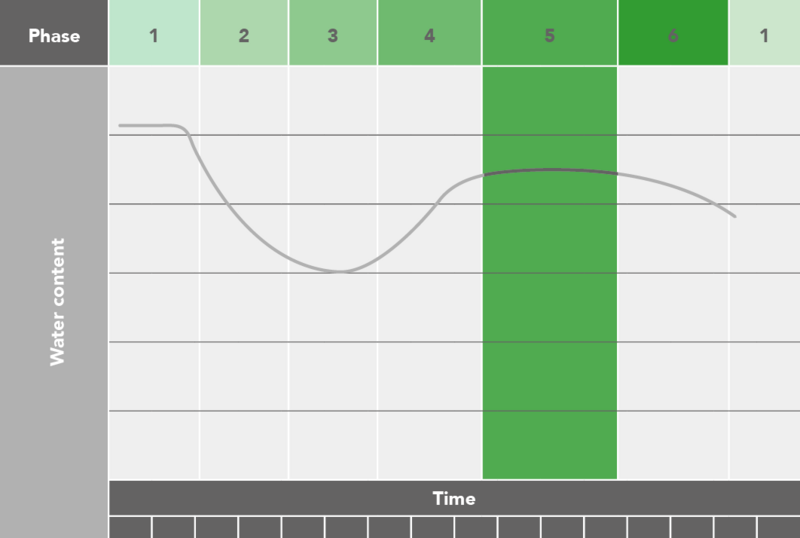
Start of phase
When production levels are stable.
End of phase
The last setting.
Objhective phase
Maintain maximum plant vigour and production potential by keeping plant and root quality in excellent health.
The outside temperatures are rising and the ventilation rate of the greenhouse is higher. Consequently evaporation will be higher which means we must apply a more
structured irrigation strategy. The table below outlines water uptake for a typical cucumber crop in full production.
| Average radiation (W/m²) | Cumulated light sum / hr (J/cm²) assuming constant radiation (W/m²) | Evaporation for a tomato crop in full production lm²/hr | |||||
| 400 | 144 | 0.29 | |||||
| 500 | 180 | 0.36 | |||||
| 600 | 216 | 0.43 | |||||
| 700 | 252 | 0.50 | |||||
| 800 | 288 | 0.58 | |||||
| 900 | 324 | 0.65 | |||||
| 1000 | 360 | 0.72 | |||||
Values can be lower (-15 to -20%) if the climate screen is being used.
Remember there are 4 key irrigation stages during the day:
Optimise start and stop times.
Keep the radiation sum used to trigger an irrigation constant throughout the entire day but vary the irrigation volume.
At this time of year the radiation sum start will be around 100 J/cm² remembering ventilation is not on summer levels. As the transpiration levels increase the irrigation
frequency can be lowered to every 70 - 80 J/cm².
Do not allow the WC% in the slab to decrease too much over night this will be at the expense of growth, vigour and fruit weight.
| Bright day - Vegetative steering | Dark day - Generative steering | ||||||
| Start time | +1.0 - 2.0 hrs after sunrise 60 - 100 J/cm² or 150 W/m² | +2.0 - 3.0 hrs after sunrise. When WC falls 1.5 - 2.0% from sunrise | |||||
| Stop time | -1.0 - 2.0 hrs before sunset. Ideally leaving 120 - 170 J/cm² and light intensity threshold 200 - 250 W/m² to sunset | -3.0 - 5.0 hrs before sunset | |||||
| Target day level WC | Increasing from 75% to >80% | 75 - 80% | |||||
| Target decrease WC overnight | 7 - 8% | 8 - 10% | |||||
| Moment 1st drain | 400 J/cm² or 600 W/m² or 4 - 6 irrigations | Less than 4 irrigations | |||||
| EC drip | 2.3 - 2.8 mS/cm | 2.8 - 3.3 mS/cm | |||||
| EC slab | 3.0 - 3.5 mS/cm | 3.0 - 3.5 mS/cm | |||||
| 24 hr drain | 30 - 35% | 20 - 25% | |||||
| Irrigation volume | 200 - 250 ml/m² | 250 - 350 ml/m² | |||||
| ml/joule | 2.8 - 3.5 ml/J | 2.5 - 3.0 ml/J | |||||
| Night irrigation | Stimulating development young fruit or shoots if decrease WC >8% | No | |||||
The strong root system formed in previous phases should benefit the crop when transpiration is highest promoting strong growth and facilitating optimum production. With GT Master 10 cm you have the benefits of an increased volume of growing media (+25%) in the middle of the slab which promotes plant vigour. The NG2.0 technology will allow you to refresh the slab solution easily ensuring fruit and plant quality is maintained. The good block / slab interaction from use of Plantop blocks in combination with GT Master 10 cm maintains a uniform WC% & EC over the entire column height of the growing media. Consequently you will observe new ‘pin’ roots emerging continually from the block and developing into the slab enhancing plant vigour and production.
The first drain on bright days should be achieved when outside light intensity reaches 600 W/m² or the light sum is 400 J/cm². This will ensure that the EC of the growing media is stabilised in time. On darker days you can use more generative steering to maintain the right balance, but only if the plant is strong enough. The irrigation efficiency of the GT Master 10 cm means you can easily refresh the EC of the growing media without excessive irrigation thereby safeguarding fruit and plant quality.
Target crop
Maintain strength and growing power of the plant and limit the ingress of disease in the crop towards final harvest.
Target root zone
Maintain a healthy and active root system and to keep the correct nutrient balance in the root zone. Maintain a stable and sufficient decrease WC% during night.
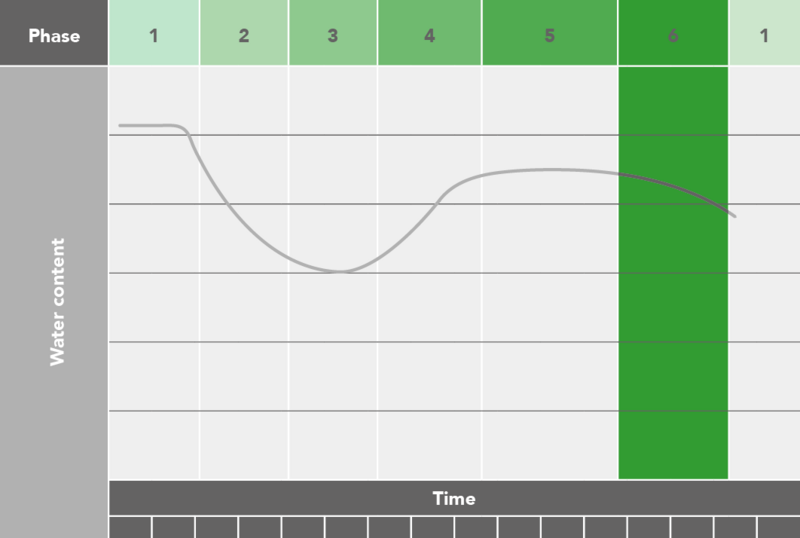
Start of phase
When the end date of the first crop has been determined. As cucumbers are replanted 1 or 2 times per year this also applies to the last setting of the final replant crop.
End of phase
When the first crop is removed. When final harvest has taken place from the last replant crop.
Objective phase
Keep the crop in a healthy condition and use the vigour to ensure production and quality is maintained right through to the last planned harvest date.
Start and stop times should coincide with plant transpiration. It is best to remove the maximum rest time setting from the first irrigation period and use a light only setting (see advice tables). The second irrigation period should contain a maximum rest time setting. Likewise the final irrigation period of the day should be based on light only starts. In this way on a dark day no starts will be given and on a bright day the starts continue (see advice table) and a stable decrease in WC% will be maintained.
The irrigation EC should remain >3.0mS (especially with radiation <600W/m²). The good irrigation efficiency of the Grodan slabs means you do not have to chase the EC of the growing media and can therefore keep irrigation under control especially in periods of changeable weather. A light reduction EC setting can be used but watch that you do not make the range too reactive, respecting the planned stop conditions.
An increasing EC at midday will have consequences for the plant’s vigour and fruit quality. In the morning start with larger irrigation volumes 4 - 5% of the volume of the growing media in order to get drain in time. In the afternoon shorter more frequent irrigations 3% of substrate volume will help keep slab WC% & EC stable and controlled.
The GroSens system is an excellent tool to assess if the irrigaiton strategy needs adjusting. The standard graphic on your climate computer should contain WC%, EC,
radiation sum (J/cm²) and radiation intensity (W/m²). If scaled correctly it is very easy to see relationships between these data points and answer the following questions:
Each growing phase of the 6 Phase advice is of course applicable to the cucumber replant crop(s). Here are some additional points of attention to prepare the slab for the next (replant) crop:
| Bright day - Vegetative steering | Dark day - Generative steering | ||||||
| Start time | +1.0 - 2.0 hrs after sunrise 60 - 100 J/cm² or 150 W/m² | +2.0 - 3.0 hrs after sunrise When WC falls 1.5 - 2.0% from sunrise | |||||
| Stop time | -1.0 - 2.0 hrs before sunset. Ideally leaving 120 - 170 J/cm² and light intensity threshold 200 - 250 W/m² to sunset | -3.0 - 4.0 hrs before sunset | |||||
| Target day level WC | >75% | 70 - 75% | |||||
| Target decrease WC overnight | 7 - 8% | 8 - 10% | |||||
| Moment 1st drain | 400 J/cm² or 600 W/m² or 4 - 6 irrigations | Less than 4 irrigations | |||||
| EC drip | 2.3 - 2.8 mS/cm | 2.5 - 3.5 mS/cm | |||||
| EC slab | 3.0 - 3.5 mS/cm | 3.2 - 3.8 mS/cm | |||||
| 24 hr drain | 25 - 30% | 15 - 25% | |||||
| Irrigation volume | 200 - 250 ml/m² | 250 - 350 ml/m² | |||||
| ml/joule | 2.8 - 3.5 ml/J | 2.5 - 3.0 ml/J | |||||
| Night irrigation | Heavy fruit load and decrease WC >8% | No | |||||
A stable decrease in WC% during the night relative to the required plant steering is most important. It will help protect root quality and keep the right plant balance towards the end of the first crop. The fast re-saturation properties of GT Master 10 cm will mean day level WC% can be easily increased to ensure enough water and nutrition is supplied to the heads of the crop on the bright days.
An increased WC% of the growing media will ensure a good block contact for the replant crop and stimulate fast rooting in.
Due to the irrigation efficiency of GT Master 10 cm you will find it easy to level the EC of the growing media as the last harvest appraoches to ready the slab for the new replant crop. Following planting it will be easy to increase the (drip and) slab EC as the nutrient demand for the fast growing re-planting crop increases.
We are a global leader in the supply of innovative stone wool substrate solutions for the professional horticultural based on Precision Growing principles.